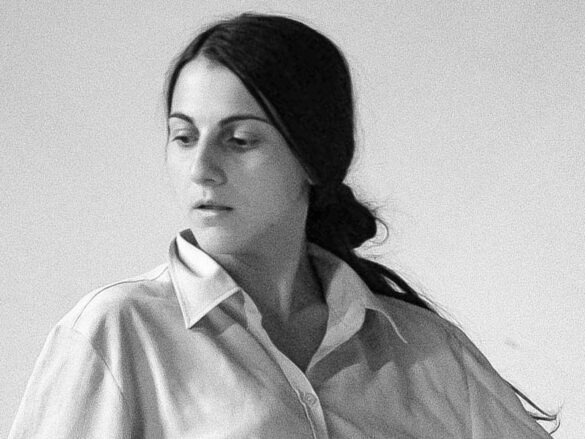
Barbara Berti
Barbara Berti is an Italian choreographer, dancer and performer, based between Italy and Berlin. After an initial training in graphic design, she moved into the performing arts, working with artists, performers and choreographers such as Judith Seng, Tino Seghal, Gabi Schilling and Isabelle Schad. At the same time she developed her own artistic vision in contemporary dance, developing a personal choreographic language through the hybridization of different disciplines (instant composition, body-mind centering, meditation and contact improvisation). In her creations she focuses her research into kinaesthetic empathy and the interactive transmission between the performer’s physical experience and the audience. In 2017 she wins ex-aequo Premio Scenario award with BAU#2. Since 2019, she has been supported by Ariella Vidach Aiep. Since 2016 he has been an artist supported by TIR Danza.
BAU#1
co/production
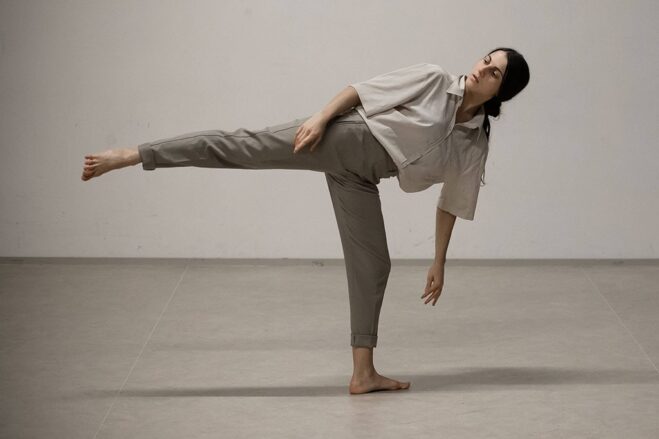
The performance series BAU – Choreography of thinking is based on research that investigates the most instinctive part of human beings, including their subconscious, as well the conscious perception of reality. Having been begun in 2013, this exploration has resulted in a work method applicable to dance and other performing arts. It focuses on the invisible connections between body and mind, activated in real time by the interaction between the performer and the viewers in a kind of dialog between their respective internal spaces. Over time, this practice was transformed into a precise stylistic approach, which puts the audience at the center of investigation – demonstrating the necessary and crucial polarity of any performance. The central question, which in a way is secularly mystical: “What does it mean to exist simultaneously in matter and non-matter? Is it possible to find a mode, a space that facilitates the perception of the unity between these two conditions?”
BAU#1 BAU #1 starts from the attention to the processes created by the “action of thinking” and the intentions such processes can produce. For example, in a space, how can we recognize a change in energy, understood as a state of the presence of the performer and the public?
Starting from some practices related to meditation,BAU #1 explores the phenomenon of disembodiment in choreographic terms, creating, seeking and recognizing the moment of separation and detachment between the action of thinking, and thought itself. In order to try to focus on that indefinable condition of presence-in-absence, between mind and body, the areas of the non-human and non-verbal are explored, across movement and word. This production aims at constructing, experiencing and analyzing a guided meditation, as an inner process in dialogue and in interaction with the audience.
Credits
ConceptBarbara Berti
Dramaturgy advise Carlotta Scioldo
Choreography assistant Liselotte Singer
Assistant light Thomas Cicognani
Production TIR Danza / MIC Ministero della Cultura
Supported by Ariella Vidach AiEP
In collaboration with Ariella Vidach AiEP NAOcrea Residenze, H(abita)T – Rete di spazi per la danza, Ballhaus Ost (Berlino) and Santarcangelo Festival
BAU#2
co/production
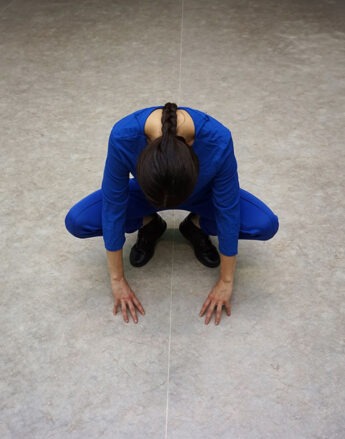
BAU# 2continues the research embarked on in BAU #1, studying in depth and in performing terms the processes that occur between thought and perception when they occur in a shared space; and how these can turn into a physical exposure, both in those who act and those who observe them. In particular, BAU # 2 wants to be an area for the verification of a mental state that allows the body to move in a specific frequency, on the border between rationality and the unconscious, finding the rhythm and condition that allows the performer to activate and incorporate a possible balance between thought and perception. The creative process is based on the development of practices that tend to expand the “Consciousness of the body” and the “Consciousness of the mind”, moving from the ritual to the performative. These practices – “Meditation of thinking”, “Meditation of the body”, “Meditation of the voice” – generate specific states that create a performative presence and a specific choreographic language. At the same time the process feeds on the connections with some theories on mental and physical processes treated in bioenergetics (Lowen). This creation takes shape and changes in the encounter with the public. The elements word, voice, body and lights create a real choreographic code aimed at creating a reality between the visible and the invisible, the material and the immaterial. BAU # 2, ultimately, is a ritual movement.
Credits
ConceptBarbara Berti
DramaturgyCarlotta Scioldo
Choreography assistant Liselotte Singer
Lights assistant Liselotte Singer, Thomas Cicognani
The situation. DOGOD
(first study)
co/production
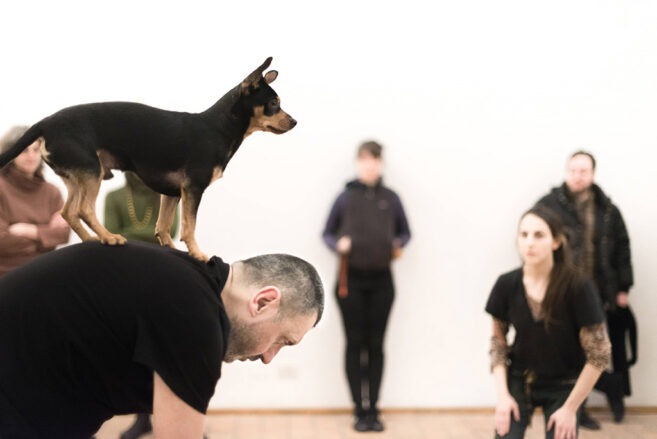
with The Situation. DOGOD (first study) Barbara Berti, together with Marco Mazzoni and Kareth Schaffer, begins the creation process with an audition for dogs. The performance brings the human animal and the non-human animal together in a safe environment that contemplates different perceptions. Ideas of fun, play and fighting induce participants to navigate instantaneous and interactive choreographic flows. The performers map and structure the space both through intimate acts of presence and the positioning of objects; blurring the boundary between animate and inanimate and continuously deconstructing the ‘situation’. The Situation draws on Donna Haraway’s suggestion to rethink the relationship between species and to “be able to join another, to see together without pretending to be another”. It assumes the unpredictable and insecure threshold in which the continuous construction and destruction of a place are both relational and empathetic. Within it, physicality is a radar, a language to communicate spatially. An expression of the territory and not of identity. A ritual to connect people beyond cultural, social, or language boundaries; a space of inclusion of all the possible beings, within the lack of social structures. Belonging to a pack, belonging to their own being, belonging to the beings.
Credits
Concept Barbara Berti
Performers and project collaborators Marco Mazzoni, Kareth Schaffer, Barbara Berti
Para-oggetti Marco Mazzoni
Production Ariella Vidach AiEP
GOLDEN DREAM
co/production
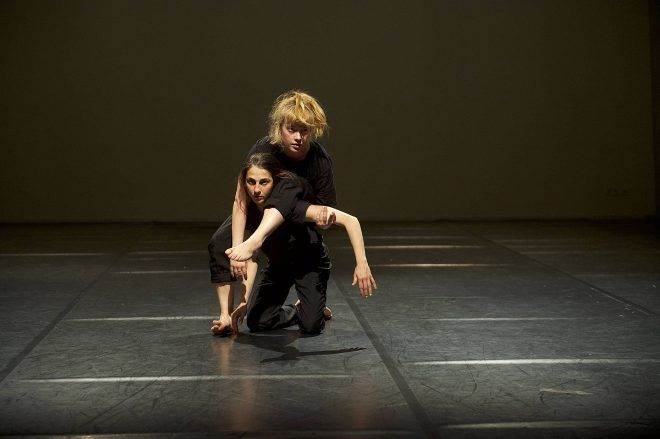
GOLDEN DREAM is an investigation of the concept of limitation. This performance brings to the conscious level the physical and mental limitations that cross us, due to external or internal restrictions, including the social and moral structures and rules that we have incorporated.
As the Korean philosopher Byung-Chul Han states, the limit in Western society is often the normative and psychological outcome of the inability to welcome the Other. In the performance, we explore a state of presence that we can experience in the passage between wakefulness and sleep, as a state that can be transported in the awaking everyday life. As well we reflect and inquire the three forms of life in which a human being could cross life: Enjoying the beautiful things, creating beautiful things for others or the contemplative form of life. How to integrate these three forms of life, in a human being? Which one are you at this very moment? Which type of collective actions in the world, could come from such an integration? How do we meet the others within this integration?
The research and performance aim to explore through a specific state, these questions, together with the audience, by meeting the audience, in verbal and non-verbal somatic communication. In the performance, we want to meet the conjunction of internal with external space as a society, reality and illusions, body, truth, micro. This is a choreographic act that through the presence, movements, and text, inquires reflects and sets the spotlights on borders, limitations, existence and how the sense of emptiness, is played in a capitalistic society, and it reflects then in the internal development of a human being. This wants to be the political act of existence of a human being, from macro to microevolution, to perceive a different presence within us, and bring this structure, manifested it outside, in the system.
Credits
Concept, choreography, texts Barbara Berti
Performers Kareth Schaffer, Barbara Berti
SoundKlaus Janek
Lights Barbara Berti
Production Ariella Vidach AiEP
Co-productionTIRDanza, Tanzfabrik, Flutgraben, Ackestadt Palast
ZoA – Zone of Acceptance
co/production
Zone of Acceptance (ZoA) is the dance of human and non-human animals and plants. ZoA is a biological interdependence that offers audiences unexpected perspectives. ZoA is an encounter with the other and a new togetherness. Is a place where perception of space opens up an interconnected sensory experience.
ZoA asks: What is this universal, aesthetic larger pattern which connects? (Bateson 1979). Bateson systematizes a cybernetic synthesis of mind and nature through the basic unit of difference. What makes evolutionary life and our meaning making it possible is the demarcation and identification of differences. The larger pattern which connects is the binding idea. Within this view Bateson identified human’s greatest failure of thinking the disjunction between our accepted ways of thinking and the ecological systems approach of ‘mind’ in nature, vividly evidenced by the continuance of humankind’s widespread ecologically disastrous economic practices. Thelarger pattern which connects is in mind and nature: within creatura and pleroma – individuals, groups, society, and the universe. With the help of plants and dogs, Zone of Acceptanceembodies and performs Bateson’s ecological vision.
Credits
Idea and coreographyBarbara Berti
Performer Paolo Rosini, Claudia Tomasi, Barbara Berti
Sound design Simon Rose
Executive Producer Iaci Lomonaco
Press Release Anita Gross
Co-productionAriella Vidach AiEP
with the support of MIC, Comune di Milano – Cultura
supported by National Performance Network – Stepping Out
in collaboration with Dialogues-Residences of Performing Arts at Villa Manin 2021
